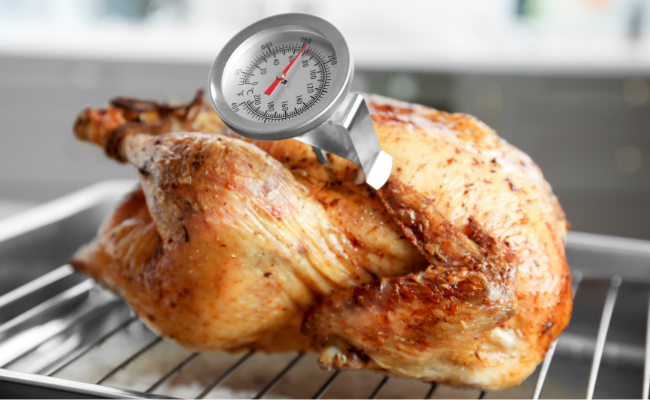How to Tell If Chicken Is Done
The lovely aroma coming from your cooking pot does not indicate that your chicken is good to go.
The satisfying taste of the chicken residue also does not mean your chicken meal is ready. But why is this the case?
The chicken is home to some of the most dreaded bacteria—Salmonella pullorum and gallinarum. Both microbes cause pullorum disease (PD) and fowl typhoid (FT).
Without properly cooking your chicken, you could end up in the hospital for salmonella food poisoning, constipation, and various illnesses.
Fortunately, there are two foolproof ways to determine when your chicken is cooked. The first involves using a kitchen thermometer, and the other with observation.
In this blog post, you’ll learn to tell if you’ve cooked your chicken properly to avoid eating raw chicken.
How to Tell When the Chicken Is Fully Cooked without a Thermometer
Incremental heating is one cooking method for many kinds of meat besides chicken. Getting the right temperature should kill the germs inside and on the surface of the chicken body.
For chicken, the ideal temperature to eliminate all bacteria present is 165 degrees Fahrenheit.
The thermometer method is the easiest and most foolproof method. But what if you don’t have a thermometer? If you’re like most people and don’t have a kitchen or meat thermometer, don’t panic.
You don’t need years of training to identify well-cooked chicken. As long as your chicken ticks all these boxes, you’re good to go.
Here are some things to look out for to know your chicken is perfect:
Has the Recommended Cooking Time Elapsed?
When it comes to cooking and food safety, you must follow the recipe to the T. Recipes not only tell you what ingredients to get but the steps to cook your food right, especially the time required.
Since the processes are different for each recipe, the cooking time won’t be. Try not to cut corners and follow the recipe’s instructions. If the cooking time calls for 45 minutes, don’t boil for 20 minutes.
Is the Chicken Juice Running Clear?
The cloudier the chicken juice, the more uncooked the chicken. For other meats, this rule doesn’t always apply.
Look out for cloudiness and redness in the chicken juice color. Once the chicken juice is clear, your chicken is cooked.
What Is the Exterior Color of the Meat?
As the chicken cooks, its color changes. Depending on your cooking method, grilling or roasting chicken produces a brownish color and reduces size.
Remember that the brown color differs from the charred color that sets off your fire alarm.
Once the chicken reaches an internal temperature of 165 degrees Fahrenheit and beyond, it will brown nicely on the outside.
What Is the Interior Color of the Chicken?
Check the thickest part of the chicken by cutting it. Generally, white indicates that the chicken is cooked. When you see pink or red, your chicken might need a few more minutes to cook.
Pink or red indicates your chicken is still on the raw side. Keep cooking and checking until you get a white color on the inside of the chicken.
What Is the Chicken’s Texture?
Chicken shrinks into a stringy texture that you can easily rip apart when cooked. Frying or baking adds a crunch to its stringy texture.
On the other hand, a dense texture shows that the chicken meat needs more cooking.
Is the Chicken Falling Off the Bone?
A good indication that the chicken is done is when it starts falling off the bone. Of course, this rule doesn’t work for boneless chicken parts like chicken tenderloin and chicken breast.
Has the Chicken Shrunk Considerably?
Have you noticed that chicken becomes smaller after cooking or frying? That’s because protein shrinks when heated. It’s only natural for chicken meat to shrink and become plumper when cooked.
How to Tell if the Chicken Is Done with a Thermometer
As said, using a thermometer is the most straightforward, precise, and foolproof method of telling if your chicken is done.
To check if your chicken is done using the thermometer, poke or insert the clean thermometer into the thickest part of the chicken until the thermometer makes it to the mid-region.
If the temperature is 165 degrees Fahrenheit, the chicken is done. If not, cook it for longer until it is done.
You can also invest in automatic meat thermometers that tell when you’ve hit the right temperatures.
How to Tell if a Baked Chicken Is Done
Baking chicken can be tricky, for starters. We recommend baking your chicken at an oven temperature of 375 degrees Fahrenheit to get an evenly cooked and juicy bird.
The time required varies according to the chicken’s weight and thickness and the oven’s temperature.
While there is no incremental chicken chart, the standard internal temperature is 165 degrees Fahrenheit. At this internal temperature, the chicken is safe to eat.
Baste the chicken skin with the marinade every half hour to prevent burning. You can also brush it with oil or cover it with aluminum foil to keep it from burning and lock in the juices.
Final Thoughts
Cooking chicken can be tricky even for the most experienced cooks. But by ticking all the boxes we’ve set here, you can enjoy chicken safely. If unsure, check for other signs in this guide or buy a meat thermometer.
Note that the time required to boil, bake or fry chicken can change depending on the size. Cut the chicken, check the color of the juices, or use a meat thermometer to know if the chicken is ready.




